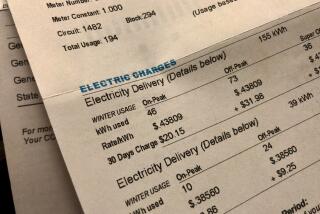SDG&E; Proposal to Tie Profit to Performance Could Lower Rates
SAN DIEGO — Signaling growing competition in the energy utility industry, San Diego Gas & Electric has asked state regulators to fundamentally alter the way its profits are set by linking earnings to overall performance and efficiency.
Traditionally, utilities have operated as monopolies, and their rates of profits were set based on investments in power-generating plants and power lines. More recently, some energy utilities have responded to increased competition by seeking to have their profits tied more closely to their ability to reduce costs and better serve their customers.
Utilities are being forced to rethink how they do business as regulators loosen their grip on key parts of the industry, said Bill Reed, SDG&E; director of regulatory affairs.
SDG&E;’s request follows similar, though less sweeping, moves by other big energy utilities to link financial returns to specific performance benchmarks. The concept is similar to one that swept the telecommunications industry after deregulation opened parts of that business to fierce competition.
SDG&E; officials want to shift that emphasis to “rewarding companies for their performance in competitive markets,” Reed said. “Right now, we have to invest more (in costly capital improvements) if we want to earn higher amounts for our shareholders. . . . That approach leads to higher costs.”
Under SDG&E;’s three-part plan, shareholders and customers would share any savings achieved if utility managers purchase natural gas below a prevailing market price set by the California Public Utilities Commission. Those groups also would benefit if SDG&E; reduces the cost of electricity generated at its own plants. In addition, savings would be passed on if the utility is able to acquire lower-cost electricity from other utilities that have environmentally clean generating plants.
More important, the utility is seeking a change in who will be accountable if the San Diego company fails to achieve the PUC-mandated goals, Reed said. Now customers and shareholders only pay extra if a project goes over cost. Under the plan, shareholders would be expected to shoulder a greater share of any losses if management fails to anticipate the direction of future energy prices.
SDG&E;’s proposal “certainly is a positive force and a positive direction . . . as long as you can develop the right (profit) standard,” said Ron Daniels, vice president of regulatory projects for Rosemead-based Southern California Edison.
Other large utilities, including SoCal Edison, Pacific Enterprises in Los Angeles and Pacific Gas & Electric Co. in San Francisco, have already begun using the performance standard on individual projects such as nuclear plants. But the San Diego company’s proposal is unique in the utility world because it is broader in scope.
Traditional utility industry regulations fail to provide the industry “a reward for being efficient,” said Ken Rose, an economist with the National Regulatory Research Institute in Columbus, Ohio.
Most of the nation’s consumer groups oppose incentive-based regulations because they fear that they would benefit utilities more than ratepayers. But Michael Shames, executive director of San Diego-based Utility Consumers Action Network, said he agrees “in concept” with SDG&E;’s proposal.
Properly supervised, Shames said, SDG&E;’s proposed regulatory framework should lower rates. For decades, the PUC has “micro-managed utilities, and utilities have proven that they can play the regulatory game,” Shames said. “What I want them to prove is that they can play a competitive free-market game.”
Shames said the PUC should stop directing the utilities’ business plans and instead act as a “cop on the corner who would regulate the industry in an increasingly competitive environment.”
SDG&E;’s incentive-based proposal is designed to give utilities enough latitude to “produce the lowest rates for customers,” said Edward Texeira, director of a PUC division that represents utility customers in commission proceedings. “You’re giving utilities an incentive to be efficient by promising them a share of the potential profit (and, more importantly) the potential losses,” Texeira said.
More to Read
Inside the business of entertainment
The Wide Shot brings you news, analysis and insights on everything from streaming wars to production — and what it all means for the future.
You may occasionally receive promotional content from the Los Angeles Times.










